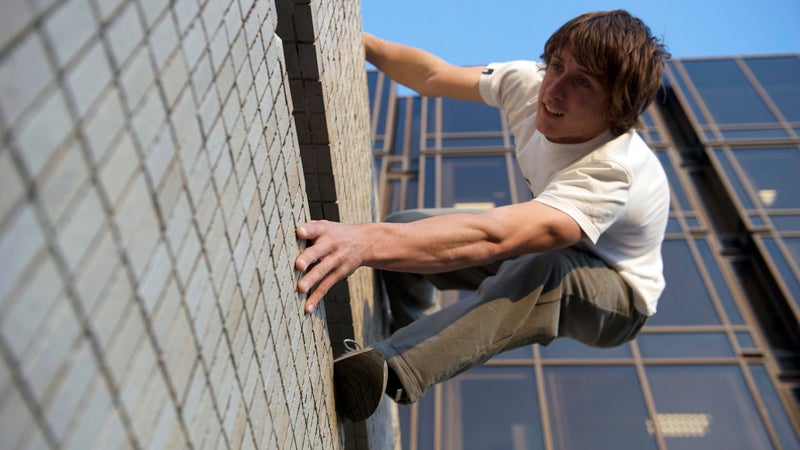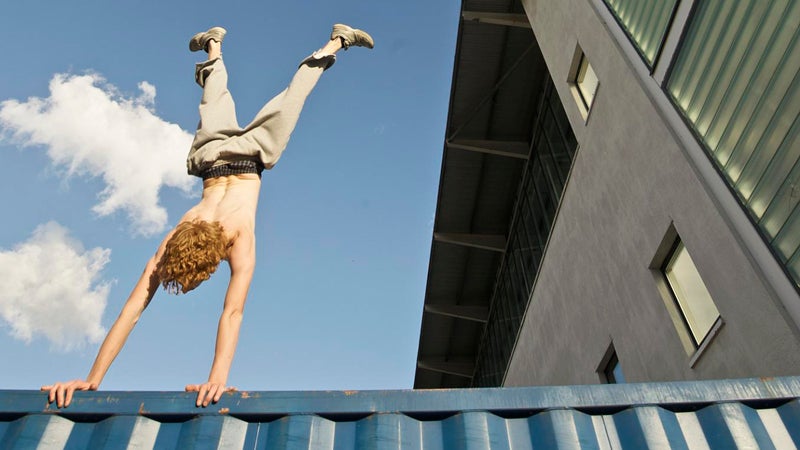You may have heard of Parkour as the butt of a joke. But it’s certainly having a moment. Parkour-specific gyms are popping up around the country, and the training discipline that involves getting from Point A to Point B as efficiently as possible—often by jumping, swinging, flipping, or rolling—is even under consideration to become an official part of the Olympic Games. Which made us wonder: Is Parkour really about more than just jumping off buildings and pretending you’re Spiderman?
It’s actually a great workout. Parkour is way more dynamic than your average trip to the gym, takes advantage of your own body weight to build strength, and will make you more agile and coordinated, says Vinny Coryell, founder of the Move to Inspire Parkour facility in Grand Junction, Colorado. “It uses every part of your body in a functional, unique way,” he says. “Instead of lifting weights, you’re lifting yourself. This activates different muscle groups that we use naturally, and makes it easier to do functional movements.”
Your mind gets a workout too. “I don’t have to have my brain on to curl a dumbbell, but if I’m jumping to an object then I’d better be paying attention to what I’m doing,” says Matt Antis, owner of Revolution Parkour in Beaverton, Oregon. Because of this, Parkour can be more engaging than many other workouts. “It’s not boring, even when doing repetitions of techniques, and it doesn’t become less fun over time.”
What to Expect

These movements won’t bulk you up; in fact, they do the opposite. “When Parkour becomes a main training method, your body begins to shed off unnecessary muscle and develops what you need, instead,” he says. “This gives any athlete an edge.”
And it’s easy to get started, says Antis, because it’s so progressive. You can and should start off with movements that are easy, safe, and close to the ground before graduating to more challenging, daredevil-esque ones. (Advanced Parkour stunts, we learned recently, can indeed be very dangerous—sometimes even fatal.)
In a typical Parkour session, athletes hit hard surfaces like walls, blocks, and the ground. When done properly, these weight-bearing movements improve bone and joint health, and build lean muscle,” says Antis. “I’ve seen people whose bodies have transformed without losing a pound of weight—they’re slightly taller, shoulders slightly wider, their entire physical appearance changed.”
One of the most rewarding things about Parkour is its community, says Antis. “We are always sharing what we learned, what we changed, how we overcame that obstacle, and how we broke that jump.” While most Americans don’t have access to a Parkour gym yet, many can find local instructors or community groups using websites like MeetUp.org or UniversalParkour.com. (Antis suggests checking out YouTube tutorials, as well.)
Try It: A 30-minute Routine

Wear comfortable, breathable clothes and sneakers with minimalist soles, suggests Coryell. “Training in thinner, full rubber bottom shoes give you the ability to feel the pressure you’re putting on each obstacle,” he says. “Thin shoes are the fastest teacher to good landings.” Find a place you can jump from curb to curb, or a low wall to wall.
A good place to start with Parkour is with the most basic form of movement, says Coryell: quadrupedal movement, or QM. “You basically move around on all fours, similar to a monkey—forward, sideways, backward, as well as up and down obstacles, while being as quiet with your movement as possible,” he explains.
Other essential skills are the ability to hit the ground rolling, to jump to and from curbs while landing on the balls of your feet, to climb small walls and rails, and to vault yourself over an obstacle with your hands. “In Parkour, repeating these movements over and over is the best form of conditioning,” says Coryell.
Start with five minutes of shoulder rolls, arm circles, and ankle rolls to warm up your joints and muscles, followed by five minutes of QM. Next, spend 10 minutes focused on precision jumping. “Try to stick your landings!”
After that, find a waist- to chest-high wall and practice getting to the top (and then back down to the ground) without using your knees. Finish up by practicing various techniques of vaulting yourself over a waist-high wall, then cool down with a good stretch. “If this is your first time doing Parkour, you will be sore,” says Coryell.
Every Parkour routine is different, and the possibilities are endless, says Antis. Try changing yours up by adjusting the height of or distance between obstacles, or by focusing on flow, speed, or acceleration.
The Future of Parkour

Making Parkour an Olympic sport would bring recognition to the discipline, says Antis, but both he and Coryell are conflicted about whether it will be good for the sport as a whole.
“Many of my students will want to train for the Olympics if it becomes a sport, and I worry that half of them will start to see Parkour as a vehicle for fame and opportunity rather than as a vehicle to make oneself more useful to society,” he says.
Coryell agrees. “To me, and many others, Parkour is about becoming better than you were the day before, expanding your creativity and your ability in general,” he says. “It’s hard to tell what direction the Olympics would take Parkour—although, I can only imagine the caliber of Olympic Parkour Athletes. That would be amazing to see.”

